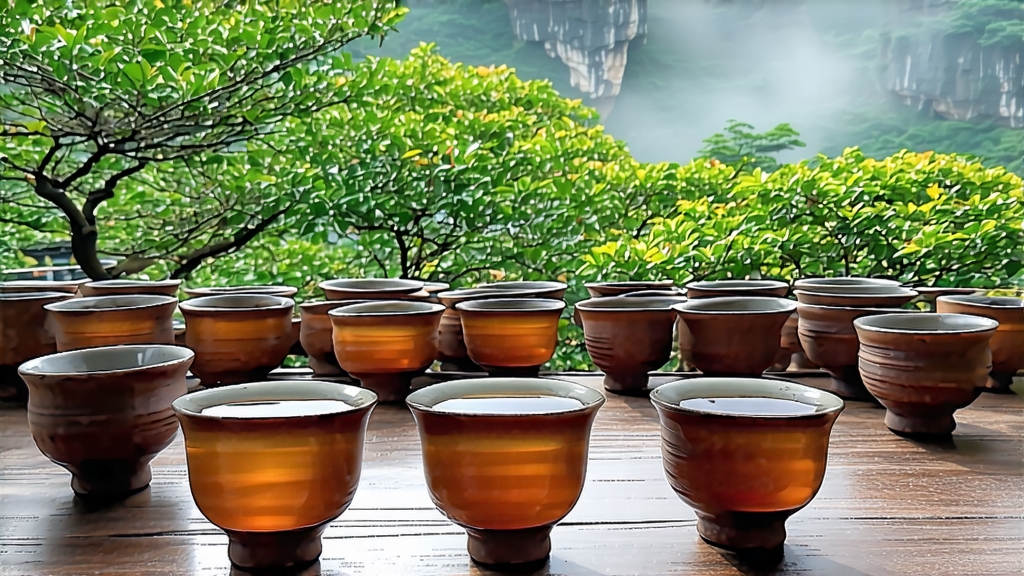
High in the jagged folds of northern Fujian’s Wuyi Mountains, a narrow gorge called the “Nine-Bend Stream” coils around cinnamon-red cliffs. On shelves of weathered Danxia stone, gnarled tea trees thrust their roots into mineral seams, sipping on the same quartz and feldspar that once built imperial palaces. From these vertiginous gardens comes Shui Xian—literally “Water Sprite”—an oolong whose perfume of orchid and wet stone has seduced poets, monks, and merchants for four centuries. To understand Shui Xian is to listen to the dialogue between fire and rock, between Song-dynasty memory and modern gongfu ritual.
History: From Song Tribute to Minnan Icon
The cultivar’s documented journey begins in the late Ming, when a Shaowing monk transplanted several old trees from nearby Jianyang to the Wuyi cliffs, believing the micro-climate could soften the leaf’s astringency. Locals noticed the new tea bore an uncanny floral note reminiscent of narcissus blossoms blooming along the stream banks; the name Shui Xian—”narcissus” in Chinese—stuck. By the early Qing, it had eclipsed the famed Song-loong tribute cakes, traveling north along the Tea-Horse Road and south to the bustling port of Xiamen, where Dutch traders rechristened it “Water Sprite” and shipped it to Java and Amsterdam. In 1804 a Wuyi monk inscribed a stele marking the “Original Six Mother Trees,” still visited today by tea scholars who touch the lichened bark like pilgrims.
Cultivar & Terroir: Rock-essence Genetics
Shui Xian is a large-leaf, medium-late budding variety (Camellia sinensis var. sinensis cv. Shui Xian) whose broad blades can measure 10 cm—ideal for the repeated rolling that coaxes out its signature “rock rhyme” (yanyun). The Wuyi UNESCO reserve spans a 650 m elevation band where daytime heat plunges into cool mist at dusk, slowing oxidation and condensing amino acids. Iron-rich igneous rock fractures into gravelly soil that drains instantly yet holds warmth; roots dive three meters, mining potassium and rare earths that translate into a lingering metallic sweetness on the tongue. Gardens are classified into three zones: Zhengyan (core cliff), Banyan (semi-cliff), and Zhouyan (river terrace), with Zhengyan lots commanding prices rivaling Burgundy grand crus.
Craft: The Charcoal Whisper
Unlike greener Tie Guan Yin, Shui Xian is a “medium-heavy” oolong, oxidized 30–40 % and then baked twice over glowing lychee charcoal. Picking occurs in late April when three leaves and a bud plump to the size of a sparrow’s tongue. After solar withering, trays are carried into chilly caves where bamboo racks encourage a 4-hour gentle shake; edges bruise, releasing grassy aldehydes that will later convert to lactones—think peach skin. Oxidation is arrested in a 230 °C wok for eight minutes, just long enough to fix the cliff-born minerality. The crucial act is the charcoal roast: pinewood is stacked, smothered, and reduced to embers that burn at 80 °C for the first 12-hour bake. A master roaster—often a third-generation “fire keeper”—rakes ash to modulate heat, sleeping in four-hour shifts lest the leaf scorch. After a month of rest, a lighter 60 °C recapture bake deepens the orchid note into honeyed narcissus while preserving the tell-tale “rock feel.”
Grades & Styles
- Traditional Charcoal (Chuan Tong): 12-hour primary roast, 6-hour second bake; liquor the color of antique mahogany; aroma of grilled peach and cliff moss.
- Light Roast (Qing Xiang): fashionable among urban millennials; brighter lime-green infusion, top-note orchid, less yanyun but creamy body.
- Aged Shui Xian (Lao Cong): stored in unglazed clay jars for 5–25 years; periodic charcoal “revival” every three years; flavors migrate toward dried longan, sandalwood, and camphor; prized by Chaozhou merchants for dim-sum service.
- “Cliff Edge” Micro-lot: hand-picked from 80-year-old trees rooted literally